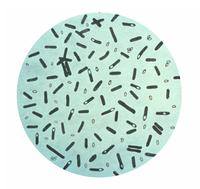
Photo from wikipedia
Clostridium difficile infection remains a common nosocomial illness with a significant impact on health care delivery. As molecular phenotyping of this organism has changed our understanding of its transmission and… Click to show full abstract
Clostridium difficile infection remains a common nosocomial illness with a significant impact on health care delivery. As molecular phenotyping of this organism has changed our understanding of its transmission and virulence, so too have diagnostic methods and treatment strategies evolved in recent years. The burden of this infection falls predominantly on elderly patients with comorbidities who have recently received antibiotics. Oral or enteral vancomycin is now preferred for first-line antimicrobial treatment across the disease spectrum, including mild-moderate initial cases. Fidaxomicin (a novel macrolide antibiotic), bezlotoxumab (a monoclonal antibody against toxin TcdB), and fecal microbiota transplantation expand the therapeutic armamentarium, particularly for recurrent infection. Operative treatment should be reserved for patients with fulminant infection, and early identification of patients who would benefit from an operation remains a challenge. Less invasive surgical options—such as laparoscopic diverting ileostomy with colonic irrigation—may improve survival and other outcomes relative to total abdominal colectomy and represent an attractive alternative particularly for frail patients.
Journal Title: Journal of Gastrointestinal Surgery
Year Published: 2019
Link to full text (if available)
Share on Social Media: Sign Up to like & get
recommendations!